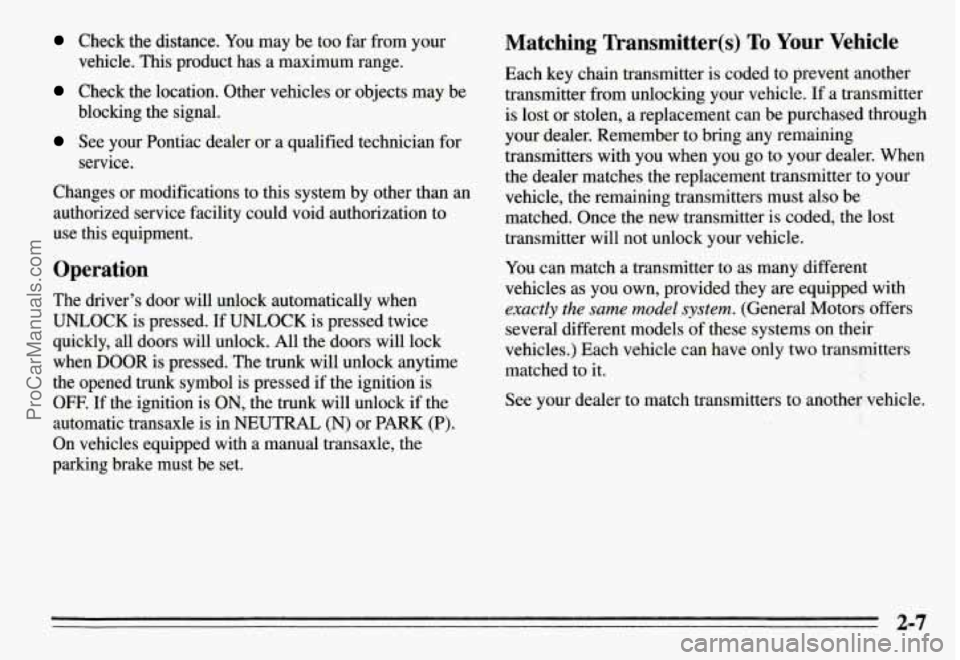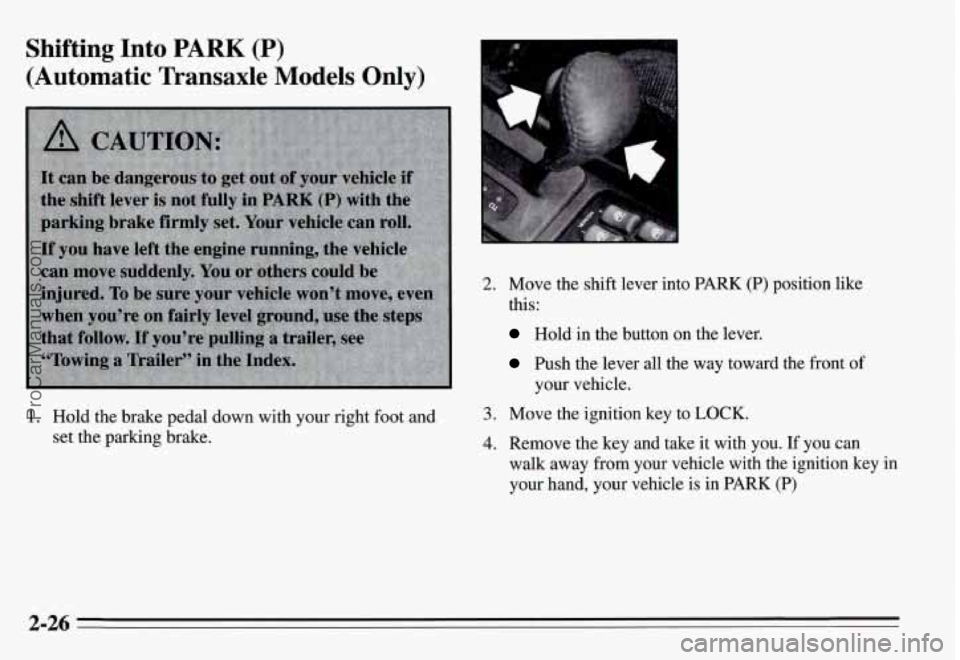1995 PONTIAC GRAND-AM parking brake
[x] Cancel search: parking brakePage 62 of 354

Check the distance. You may be too far from your
Check the location. Other vehicles or objects may be
vehicle. This product has a maximum range.
blocking the signal.
See your Pontiac dealer or a qualified technician for
service.
Changes or modifications to this system by other than an
authorized service facility could void authorization to
use this equipment.
Operation
The driver’s door will unlock automatically when
UNLOCK is pressed. If UNLOCK is pressed twice
quickly,
all doors will unlock. All the doors will lock
when DOOR is pressed. The trunk will unlock anytime
the opened trunk symbol is pressed if the ignition is
OFF. If the ignition is ON, the trunk will unlock if the
automatic transaxle is in NEUTRAL
(N) or PARK (P).
On vehicles equipped with a manual transaxle, the
parking brake must be set.
Matching Transmitter(s) To Your Vehicle
Each key chain transmitter is coded to prevent another
transmitter from unlocking your vehicle. If a transmitter
is lost or stolen, a replacement can be purchased through
your. dealer. Remember
to bring any remaining
transmitters with you when you
go to your dealer. When
the dealer matches the replacement transmitter to your
vehicle, the remaining transmitters must also be
matched. Once the new transmitter is coded, the lost
transmitter will not unlock your vehicle.
You can match a transmitter to as many different
vehicles as you own, provided they are equipped with
exactly the same model system. (General Motors offers
several different models
of these systems on their
vehicles.) Each vehicle can have only two transmitters
matched to
it.
See your dealer to match transmitters to another vehicle.
ProCarManuals.com
Page 78 of 354

THIRD, FOURTH and FIFTH (3,4 and 5): Shift into
THIRD (3), FOURTH (4) and l?lFTH (5) the same way
you do for
SECOND (2). Slowly let up on the clutch
pedal as you press the accelerator pedal.
To Stop: Let up on the accelerator pedal and press the
brake pedal.
Just before the vehicle stops, press the
clutch pedal and the brake pedal, and shift into
NEUTRAL
(N).
NEUTRAL (N): Use this position when you start or
idle your engine.
REVERSE (R): To back up, press down the clutch
pedal and shift into REVERSE
(R) Let up on the clutch
pedal slowly while pressing the accelerator pedal.
I NOTICE:
Shift to REVERSE (R) only after your vehicle is
stopped. Shifting to REVERSE (R) while your
vehicle is moving could damage your transaxle.
Also, use REVERSE (R), along with the parking brake,
for parking your vehicle.
Shift Light
0
SHIFT
If you have a manual
transaxle, you have a
SHIFT light. This light will
show
you when to shift to
the next higher gear for best
fuel economy.
k' . :I
When this light comes on, you can shift to the next
higher gear if weather, road and traffic conditions let
you. For the best fuel economy, accelerate slowly
and
shift when the light comes on.
While you accelerate, it is normal for the light to go on
and
off if you quickly change the position of the
accelerator. Ignore the
SHIFT light when you downshift.
Shift Speeds (Manual Transaxle)
This chart shows when to shift to the next higher gear
for best fuel economy.
2-23
ProCarManuals.com
Page 80 of 354

Parking Brake
To set the parking
brake hold the regular
brake pedal down with
your right foot. Push
down the parking
brake pedal with your
If the ignition is on, the brake system warning light will
come on.
To release the parking
brake hold the regular
brake pedal down. Pull the
BRAKE
RELEASE lever.
Driving with the parking brake on can cause
your rear brakes to overheat. You may have to
replace them, and you could also damage other
parts
of your vehicle.
If you are towing a trailer and are parking on any hill
see “Towing a Trailer” in the Index. That section shows
what to do first to keep the trailer from moving.
2-25
ProCarManuals.com
Page 81 of 354

Shifting Into PARK (P)
(Automatic Transaxle Models Only)
2. Move the shift lever into
this:
Hold in the button on
Push the lever all the
your vehicle.
PARK (P) position like
I the lever.
way toward the front of
1. Hold the brake pedal down with your right foot and 3. Move the ignition key to LOCK.
set the parking brake. 4. Remove the key and take it with you. If you can
walk away from your vehicle with the ignition key in
your hand, your
vehicle is in PARK (P)
2-26
ProCarManuals.com
Page 82 of 354

Leaving Your Vehicle With the Engine Running (Automatic Wansaxle Models Only)
If you have to leave your vehicle with the engine
running, be sure your vehicle is in PARK (P) and your
parking brake is firmly set before you leave it. After
you’ve moved the shift lever into the PARK (P)
position, hold the regular brake pedal down. Then, see if
you can move the shift lever away from PARK (P)
without first pushing the button.
If you can, it means that the shift lever wasn’t fully
locked into PARK (P).
Torque Lock (Automatic Transaxle)
If you are parking on a hill and you don’t shift your
transaxle into PARK (P) properly, the weight of the
vehicle may put too much force on the parking pawl in
the transaxle. You may find it difficult to pull the shift
lever out of PARK (P). This is called “torque lock.” To
prevent torque lock, set the parking brake and then shift
into PARK (P) properly before you leave the driver’s
seat. To find out how, see “Shifting Into PARK (P)” in
the Index.
When you are ready to drive, move the shift lever out of
PARK (P)
before you release the parking brake.
If “torque lock” does occur, you may need to have
another vehicle push yours a little uphill to take some of
the pressure from the transaxle,
so you can pull the shift
lever out of PARK (P).
2-27
ProCarManuals.com
Page 83 of 354

Shifting Out of PARK (P)
(Automatic Transaxle Models Only)
Your Pontiac has a brake-transaxle shift interlock. You
have to fully appZy your regular brakes before you can
shift from PARK (P) when the ignition is in the RUN
position. See “Automatic Transaxle” in the Index.
If you cannot shift out of PARK (P), ease pressure on
the shift lever
-- push the shift lever all the way into
PARK
(P) -- as you maintain brake application. Then
move the shift lever into the gear you want. (Press the
shift lever button before moving the shift lever.)
If you ever hold the brake pedal down but still can’t
shift out of PARK (P), try this:
1. Turn the key to OFF, not LOCK.
2. Apply and hold the regular brake until the end of
Step 4.
3. Shift to NEUTRAL (N).
4. Start the vehicle and then shift to the drive gear you
want,
5. Have the vehicle fixed as soon as you can.
Parking Your Vehicle (Manual
Transaxle Models Only)
Before you get out of your vehicle, put your manual
transaxle in
REVERSE (R) and firmly apply the parking
brake.
If you are parking on a hill, or if your vehicle is
equipped to tow
a trailer, see ‘Towing a Trailer” in the
Index.
2-28
ProCarManuals.com
Page 98 of 354

Instrument Panel Intensity Control
You can brighten or dim your instrument cluster lamps
by rotating the instrument panel intensity control switch.
Rotate the switch all the way to the right to turn on the
interior courtesy lamps. Rotate the switch to the left to
turn off the instrument cluster lamps and displays.
Fog Lamps
The switch for your fog lamps is next to the instrument
panel intensity control.
Push the top of the switch
to turn the fog lamps on.
When using fog lamps, the parking lamps or low beam
headlamps must be on.
Fog lamps will go off whenever the high beam
headlamps come on. When the high beams go off, the
fog lamps will come on again.
Daytime Running Lamps (Canada Only)
Daytime Running Lamps (DRL) can make it easier for
others to see the front
of your vehicle during the day.
DRL can be helpful in many different driving
conditions, but they can be especially helpful in the
short periods after dawn and before sunset. Several
countries, including Canada, require
DRL.
A light sensor on top of the instrument panel makes the
DRL work,
so be sure it isn’t covered. The DRL system
will make your high beam headlamps come on at
reduced brightness when:
The ignition is on,
0 The headlamp switch is off, and
0 The parking brake is released (manual transaxle).
The shift lever is not in PARK (P) or NEUTRAL (N)
(automatic transaxle).
2-43
ProCarManuals.com
Page 99 of 354

When the DRL are on, only your high beam headlamps
will be on. The taillamps, sidemarker and other lamps
won’t be on. Your instrument panel won’t be lit up
either.
When it’s dark enough outside, your headlamps will
come on at
full brightness. The other lamps that come
on
with your headlamps will also come on. When it’s
bright enough outside, the regular lamps will go
off and
your high beam headlamps change to the reduced
brightness
of the DRL.
To idle your vehicle with the DRL off, set the parking
brake On a manual transaxle or put the vehicle in
PARK (P) or NEUTRAL (N) on an automatic transaxle,
while the ignition is
in the OFF or LOCK position. Then
start the vehicle. The DRL will stay off until you release
the parking brake on a manual transaxle or shift out
of
PARK (P) or NEUTRAL (N) on an automatic transaxle.
As with any vehicle, you should turn the regular
headlamp system on any time you need it.
Front Reading Lamps (Option)
These lamps and the interior courtesy lamps will come
on when you open the doors.
To turn on a reading lamp when the doors are closed,
press the button. Press
it again to turn the lamp off.
2-44
ProCarManuals.com